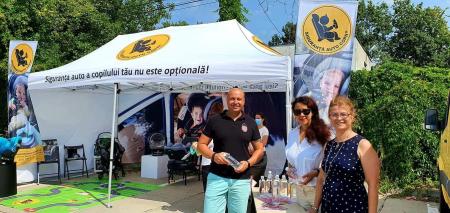Our members are dedicated to improving road safety and sharing their knowledge with the wider community. Here, you can explore our members' good practices – initiatives that have been assessed for their effectiveness in addressing a road safety problem and have proven results.
Get inspired – and sign up to share your good practices too!

to
The risk potential on German roads remains high: Even in 2020 with less traffic due to the Covid-pandemic, the police counted 264,000 traffic accidents with people injured or killed . Improvements have been scarce and the numbers have been stagnating over the last decade. Especially in cities, this trend is due to increased traffic volume, new means of transport (such as pedelecs, small electric vehicles) and distraction when driving. Dangerous situations are often misjudged or not recognized on time. The goal of EDDA+ (acronym for "Early Detection of Dangerous Areas in road traffic using smart data", German: FeGiS+) is to identify risks in road traffic at an early stage to avoid collisions by means of timely warnings or preventive measures. We want to achieve this by making better use of existing safety-related data and tapping into new data sources, thus contributing to better road safety. On the one hand, the EDDA+ information is to be incorporated into intelligent applications for road users to provide timely warnings of danger zones and to indicate safe routes in terms of roads, cycle paths and footpaths. On the other hand, this continuously updated data is to be compiled on a platform and made available for the first time throughout Germany to those involved in road safety work such as local authorities, police, science, engineering offices, navigation providers and car manufacturers for road safety and prevention work.

One of the major challenges in road safety that we are facing in Romania is the high number of victimization among young passengers (group age 0-14) and main reason why this is happening is the low rate of utilization of child restraint systems (only 26% of children passengers are transported in an age-appropriate child restraint system). Data was obtained through an observational study that we made last year and presented at TUV Conference :Protection of Children in Cars - December 2020. We want to address this challenge by educating future parents and parents as well as children from primary schools and kindergartens regarding correct way of travelling as young passengers as well as by increasing public awareness on this topic by a strong and constant PR campaign promoting child restraint systems and seat-belt use. Decreasing the incidence of serious road accidents in Romania involving child victims is the aim with a target of 0 deaths by 2030, in accordance with Vision Zero, the ambitious European traffic safety project, and to increase the use of car seats from 20% as it is currently to 70% by 2025. We target parents, caregivers, children.

to
As a result of a road accident, debris and waste from the parts from the vehicles often are left on the roads which, if not removed and promptly cleaned, can become a risk factor for the occurrence of new accidents. Due to the lack of operational resources and technical expertise, the waste from the cars, namely, oil, fuel, plastics and glasses, remain on the pavement, making them less safe and more polluted. Other times, the residues are cleaned with contaminating products and/or left on the side of the road, ending up on the ground, or simple wasted away with fire hoses to the fields, contaminating water lines and the surrounding areas. Some accidents can also cause damage to road safety equipment, which is essential for the safety of the drives or for the regular information placed on the roads, like vertical signage, protective barriers, information boards, among others. Eurosistra Portugal, Lda., with the registered brand "Seguranca e Ambiente" meaning Safety and Environment - manages, through its daily work, to act on these three main issues: Restore the Road Safety (by a proper and innovative solution and equipment for cleaning the road and removing and recycling all the waste recovered from the car accidents); the protection of the environment through the use of biological products and the removal of waste, including the liquids (that are usually washed away by other entities that work in this area); and finally the identification of damaged Urban Equipment, sent to the Civil Protection of the Townhall in which the accident occurred, in order to assure its fast replacement. Reinforcing and strengthening road safety, protecting drivers and all those who travel on the roads, as well as protecting and respecting the environment, are the basic principles on which our project is built, which are set up in the European Road Safety Charter. EUROSISTRA PORTUGAL established an ambitious objective called “ OBJECTIVE ZERO ACCIDENTS AFTER AN ACCIDENT", with the strong belief that this project has a direct and important contribution to reducing accidents caused due the existence of waste from a previous accident that was not taken care of in the proper way, whether by poor cleaning or no cleaning at all. Thus, the main objectives of this project are: - Reduce the rate of road accidents caused by the inexistent or poor cleaning of pavements after a road accident; - Ensure the correct and safe return to normal road traffic in the shortest possible time, assuring the reestablishment of road safety; - Contribute to the Environmental Protection by cleaning the roads according to legal requirements, in particular to environmental legislation, and thus, also promoting sustainable policies directed to reducing road accidents. The target audience of Eurosistra Portugal are all agents and entities that manage roads and their safety, namely the Municipalities/City Halls, Road Concessions and Civil Protection, along with other entities called upon when a car accident occurs, namely police and fireman. Since it is their responsibility to keep the roads safe, we ally to these entities to improve road safety conditions and reduce the car accidents, through establishing protocols and partnerships that allow us to implement the service on their roads and to have a closer relationship with the operational and civil protection agents.

to
Aujourd'hui les Sapeurs-Pompiers sont confrontes à des plus en plus d'interventions qui les amenent à utiliser un vehicule de secours tres regulièrement. Les conditions de circulations sont devenues difficiles de part le nombre croissant d'usagers de la route, l'augmentation des incivilites routieres avec aussi la multiplication des utilisateurs de velos et autres engins de d'eplacements electriques et du fait qu'aujourd'hui on ne facilite plus le passage des vehicules d'urgence. En interne, les SDIS tentent de mettre en place des modules de formations specifiques à la conduite d'urgence d'un vehicule d'intervention mais n'ont pas toujours les ressources competentes en interne pour dispenser des formations efficaces. leur metier leur apporte aussi des contraintes quant à l'utilisation des vehicules. Certains conducteurs ne parcourent qu'une cinquantaine de kilometres par an sur certains type de vehicule de type echelle ou autre ce qui entraine des accidents souvent li y a une non maitrise du gabarit ou de la dynamique de ces vehicules. Recemment les pompiers ont eu une derogation pour pouvoir conduire des vehicules d'un poids pouvant aller jusqu'a 4.5 tonnes avec un simple permis voiture, or cette tonne supplementaire à une incidence importante sur le comportement du vehicule et sur sa conduite. Il est donc imperatif pour l'ensemble des SDIS de France de mettre en place ces formations. BBE DEVELOPPEMENT, de part son expertise du metier de sapeur-pompier et avec l'aide de nombreux SDIS qui se sont reunis pour echanger autour de leurs besoins pedagogiques, a developpe plusieurs programmes de formations à destination soit des conducteurs finaux soit des moniteurs internes pour former et sensibiliser les equipages aux bonnes pratiques de conduite et reduire ainsi l'accidentologie routiere au sein des SDIS. Nos objectifs etaient de pouvoir apporter aux SDIS des solutions pedagogiques concretes, innovantes et facile d'emploi afin de facilement s'inserer dans leur programme de formation interne ou de leur apporter notre expertise pour se former comme moniteur interne ou comme simple conducteur de vehicule d'urgence. nous avons donc travaille sur des solutions clÃs en main. Nous nous adressons soit à des moniteurs internes qui ont besoin de se former sur de nouvelles competences afin de pouvoir dÃployer eux-memes des ateliers de sensibilisation ou des formations sur les risques routiers lies au mÃtier de sapeur-pompier, soit de former directement les conducteurs et les equipages dans le cadre de la formation continue des personnels de secours.

to
A 2018 report from the World Health Organization (WHO) found that the number of road casualties continues to rise, reaching 1.35 million per year. Road crashes have become the main cause of death for children and young people aged 5 to 29. And more than half of road accident victims are vulnerable road users: pedestrians, cyclists, motorcyclists, etc. The probability of dying in a road crash also remains three times higher in low-income countries than in high-income countries, mainly due to a lack of regulations and infrastructures, as well as vehicle standards or first aid efficiency. Faced with these staggering figures, the association Prévention Routière and its partner, the Group Renault Corporate Foundation, have decided to act, by creating the first universal platform intended for all audiences. The Road4us platform aims to raise users' awareness of road hazards, as well as the proper behaviours to adopt to move safely. To accommodate all type of audiences, these prevention messages are spread in the form of simple and entertaining illustrations, designed for everyone. The overall objectives are to reduce road accidents and deaths worldwide, to make road prevention content available to as many people as possible, and to be universal and multilingual. As an initiative with a universal scope, the project targets all road users and aspires to be understood by people from all nationalities and culture, children and adults, illiterate, and literate. This project also offers free resources to print (in both colors and black & white) or to download online to all organizations involved in road safety around the world.